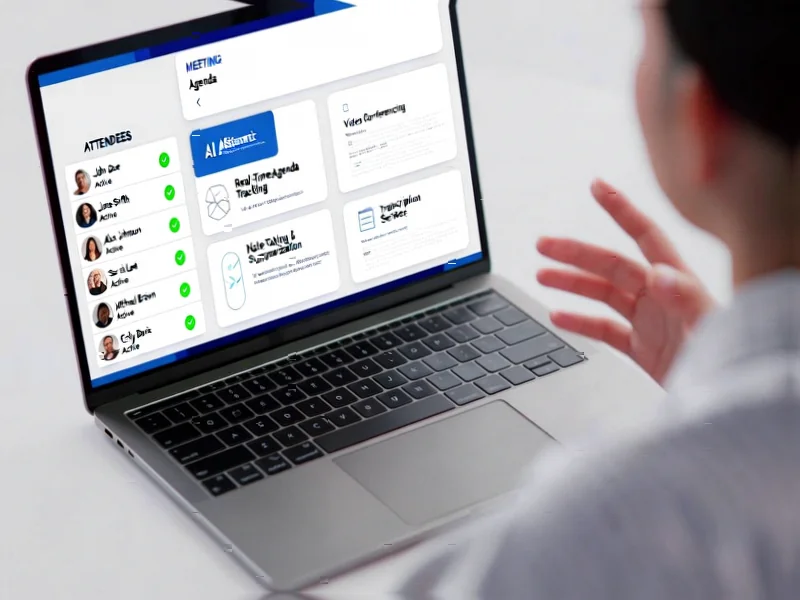According to Windows Report | Error-free Tech Life, Microsoft is rolling out a new AI-powered meeting assistant called Facilitator in Teams that makes meetings more focused, structured, and productive. The feature manages agendas, tracks discussions, and summarizes key points in real time while highlighting progress and capturing important notes and decisions as meetings unfold. Users can engage with the tool using simple chat commands like “@Facilitator add this to the agenda” and it integrates with Planner for follow-up tasks while drafting documents in Word or Loop directly from meeting content. The feature is now available for Teams users with a Microsoft 365 Copilot license across Windows, Mac, mobile, and web, though some advanced features like task tracking and document creation remain in Public Preview. This development represents Microsoft’s latest move to address one of enterprise productivity’s most persistent challenges.
Table of Contents
The Billion-Dollar Meeting Problem
The timing of Facilitator’s launch couldn’t be more strategic. Research consistently shows that Microsoft and other enterprise software providers are targeting what analysts estimate to be a $37 billion annual productivity loss from inefficient meetings. Middle managers typically spend 35% of their workweek in meetings, while upper management dedicates up to 50% – much of which is wasted on unstructured discussions, unclear action items, and poor follow-through. The hybrid work revolution has exacerbated these issues, creating new challenges around participant engagement and information alignment between remote and in-office attendees. Microsoft’s solution directly addresses these pain points by providing the structured facilitation that many meetings lack.
The AI Meeting Assistant Arms Race
Microsoft isn’t operating in a vacuum here. The enterprise artificial intelligence market for meeting productivity has become fiercely competitive, with companies like Zoom launching its own AI Companion, Salesforce integrating Einstein Copilot, and startups like Otter.ai and Fireflies.ai gaining traction. What makes Microsoft’s approach particularly compelling is its deep integration within the existing Microsoft Teams ecosystem. Unlike standalone solutions that require additional logins and context switching, Facilitator operates seamlessly within the workflow millions of professionals already use daily. This integrated approach could give Microsoft a significant advantage in adoption rates, though it risks alienating organizations using competing collaboration platforms.
Technical Implementation Challenges
The promise of real-time computing for meeting facilitation presents several technical hurdles that Microsoft will need to overcome. Real-time agenda management and note-taking require sophisticated natural language processing that can distinguish between substantive discussion and casual conversation. The system must accurately capture action items while filtering out unrelated commentary – a challenge that even human assistants sometimes struggle with. Additionally, the integration with Microsoft 365 Copilot raises questions about data privacy and information security, particularly given Microsoft’s clarification that external participants cannot access Facilitator-generated notes. Organizations in regulated industries will need clear assurances about how meeting data is processed and stored.
The Human Dynamics of AI-Facilitated Meetings
Perhaps the most intriguing aspect of Facilitator isn’t technical but psychological. The introduction of AI moderation could fundamentally alter meeting dynamics in ways we’re only beginning to understand. Will participants feel more comfortable speaking freely knowing an AI is tracking their contributions? Or might it create a chilling effect, with employees self-censoring to avoid creating permanent AI-generated records of their comments? The tool’s ability to provide “midway and wrap-up reminders” could help keep meetings on track, but might also introduce new tensions if participants feel rushed or micromanaged by an algorithm. Organizations will need to develop new norms around AI-facilitated collaboration to maximize benefits while minimizing unintended consequences.
Market Implications and Future Outlook
Microsoft’s Facilitator represents a significant step toward the autonomous workplace, where AI handles administrative overhead while humans focus on creative and strategic work. The feature’s current limitation to Microsoft 365 Copilot licensees creates an interesting pricing dynamic – at $30 per user per month, organizations must weigh whether the productivity gains justify the additional cost. Looking ahead, we can expect these AI meeting assistants to evolve from passive note-takers to active participants that might eventually suggest alternative discussion approaches, identify unspoken conflicts, or even recommend when a meeting should be canceled altogether. The companies that master this balance between AI assistance and human judgment will likely dominate the next era of workplace productivity tools.



